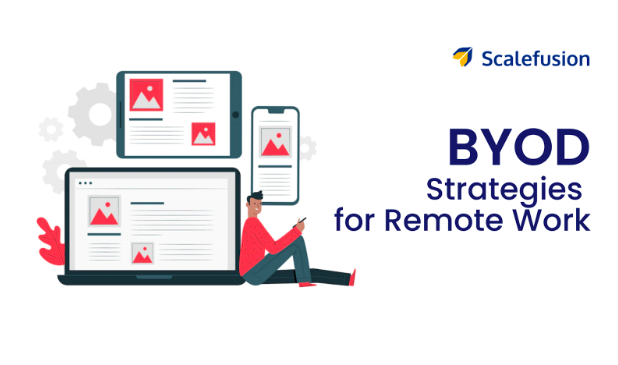
Introduction
Gone are the days when businesses strictly provided company-owned devices to their employees and the entire workforce operated from within confined office spaces. We now live in an age of enterprise mobility. Remote working is the new normal and several businesses have embraced BYOD management. In a BYOD work environment, employees are allowed to use their personal devices to access corporate resources. While the benefits of BYOD are tremendous, including greater employee productivity, device familiarity and reduced need for IT support, businesses must be aware of how to construct an efficient BYOD policy. Adopting BYOD is just half the job done, unless you implement the right BYOD strategies for your business, you can still face a number of challenges.
Key Challenges of BYOD Management
The best way to devise a corporate strategy is to be aware of the various challenges that are involved in the process. Here are some of the major BYOD management challenges that you must know.
-
Security Risks
The greatest risk of allowing employees to access corporate information remotely on their personal devices is that of corporate data breaches. Employees working remotely may connect to any and every WiFi network that is available. Not all WiFi networks are secure, especially the open ones available in cafes and public places. Connecting to such untrusted networks can pose a severe risk of malware infiltration. Additionally, storage of corporate data on portable devices such as smartphones and laptops poses the risk of your sensitive business information falling into the wrong hands in case these devices get misplaced.
-
BYOD Compliance Issues
When employees use their personal devices for work, especially in informal workplaces such as their homes or restaurants, they are prone to breaking a few corporate compliance policies. Businesses always want their corporate information to be handled carefully. However, it is difficult for businesses to keep track of their corporate data usage when it is accessed from employees’ personal devices. Businesses struggle with compliance checks and gaining finer control over their employees’ devices.
-
Lifecycle Management Complexities
Allowing employees to connect to the corporate networks and store the business data on their devices is acceptable as long as they are working with your organization. What happens to the corporate data once the employee leaves your organization? Businesses are challenged with the end-to-end lifecycle management of BYO devices, right from provisioning multitudes of devices with corporate tools, to ensuring a secure retirement.
-
Privacy of Employees’ Personal Data
It is a given that when employees use their personal devices for work their devices will store both the employees’ professional and private data. Ensuring that the professional data is kept strictly separate from the employees’ private data is a complex task. Businesses must ensure that the employees’ private data does not get hampered, as well as the professional data does not get compromised.
Most Effective BYOD Management Strategies for Remote Work
1. Restricted Access to Corporate Resources
Allowing your employees to use their personal devices for work from any location of their choice poses great risks of accidental data loss. The best way to reduce the risk of accidental corporate data loss is to provide employees bear minimum remote access to corporate networks and resources. With this strategy, businesses can give limited access to only those tools and resources that the employees require. It indirectly reduces the risk of mobile app malware infiltration or misuse by employees.
2. Enable Data Containerization
When employees use their personal devices for work, they resist corporate restrictions and policies on their devices. However, in order to prove remote access to sensitive business information, enterprises need to secure their employees’ devices with extensive security configurations against corporate data loss. Data containerization is the best way to strike a balance between the needs of employers and employees.
This strategy allows company IT admins to create isolated containers on employees’ personal devices which hold all the business information. All the corporate security policies are applied to this container alone, without hampering the rest of the device’s functionalities.
3. Enforce Strong Passcode Policies
Generally, people are not very strict about maintai ning strong passwords on their personal devices. People tend to keep passwords that are easy to recall. However, when employees carry confidential corporate files on their personal smartphones and laptops, keeping strong passcodes acts as the first line of defense. Businesses must enforce strong passcode policies that define the complexity and strength of the passwords for their corporate folders and apps. This prevents unauthorized access to corporate folders.
4. Encrypt Your Corporate Data
The most common cause of security breaches that businesses must consider when adopting a BYOD work environment is the loss or theft of employees’ devices. Mobile devices such as smartphones, tablets and laptops are portable and prone to being misplaced. If these devices fall into the wrong hands, they can present a great risk of data leakage. Apart from enforcing strong passwords, businesses can add an extra layer of security with data encryption.
Data encryption is converting sensitive corporate information into codes that can be decoded only using specific keys. This means, that even if employees’ BYO devices fall in the wrong hands, the corporate data present on the devices cannot be deciphered and misused by strangers.
5. Implement Cloud-Computing
Cloud computing proves extremely beneficial in a remote BYOD work environment. Not only to share business resources instantly but also to ensure backup of corporate data. In cloud computing, the corporate information isn’t store directly on the employees’ mobile devices. But instead on a secure cloud storage space with a security backup. MDM solutions for BYOD management allow businesses to remotely wipe off the data from their employees’ devices in events of loss or theft. In such cases, businesses need not worry about their corporate data being lost forever, they can retrieve their data that has been backed up on the cloud, easily.
6. Configure VPN on Employees’ Devices
The most common way for businesses to secure their corporate communications for a remote working BYOD setup is to configure a VPN on their employees’ devices. VPN ensures that your IP address is secured and prevents untrusted traffic from connecting to your networks. This goes a long way in preventing hackers from breaking into your corporate systems.
7. Take App Updates Seriously
Ever since remote working has normalized, a majority of business operations are carried out using various mobile apps. Hackers have become extremely sophisticated these days and mobile malware has become one of the most common types of cyber attacks. With every new app version, app developers carry out bug fixes and patch fixes in their apps. Ensuring timely upgrade of your line of business apps, whether public or private can help businesses prevent falling prey to mobile malware infiltration due to app vulnerabilities.
8. Enable Remote Troubleshooting
Working from remote locations with a heavy dependence on digital devices calls for instant IT support whenever the employees need it. Ensuring real-time remote IT support and troubleshooting for your employees can help businesses save time and productivity.
9. Educate Your Employees
The most overlooked business strategy to ensure security compliance is to educate your workforce on BYOD best practices. Your employees must be make aware of the consequences of showing carelessness towards corporate data security. Similarly, they must be make aware of the do’s and don’t of accessing corporate data on their personal devices. No matter how many security policies you impose on your employees’ personal devices, you can ensure maximum data protection only with the complete cooperation of your workforce.
10. Adopt an MDM With Cross-OS Support
The last, yet crucial aspect that businesses need to consider before adopting remote BYOD management is the implementation of an Android MDM solution with cross-OS support. When you allow your employees to use their personal devices for work, you have to consider the fact that not all devices will belong to a common OS type. Implementing MDM solutions like Scalefusion that support all the major OS types such as Android, iOS, macOS and Windows 10 helps businesses gain a central point of control for their versatile devices.
Closing Lines
BYOD is a win-win situation provided businesses adopt the right BYOD management strategies to secure their corporate data and ensure proper usage of their resources. Several businesses around the world have turned to MDM solutions to manage their BYOD environments.
Author Bio:
Shambhavi is a Content Writer with experience in commercial writing, creative planning, product cataloging, and content strategizing. She is a “Biotechnologist turn writer” and believes that the inception of great ideas happens over coffee.



